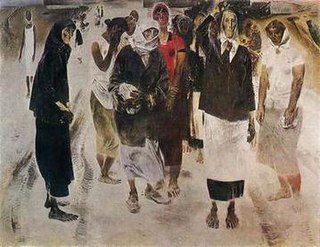Related Research Articles
Belarusians, also and Byelorussians, are an East Slavic ethnic group who are native to modern-day Belarus and the immediate region. There are over 9.5 million people who proclaim Belarusian ethnicity worldwide, with the majority residing either in Belarus or the adjacent countries where they are an autochthonous minority.

Es is a letter of the Cyrillic script.

The S-300 is a series of initially Soviet and later Russian long range surface-to-air missile systems produced by NPO Almaz, based on the initial S-300P version. The S-300 system was developed to defend against aircraft and cruise missiles for the Soviet Air Defence Forces. Subsequent variations were developed to intercept ballistic missiles. The S-300 system was first deployed by the Soviet Union in 1979, designed for the air defence of large industrial and administrative facilities, military bases and control of airspace against enemy strike aircraft. The system is fully automated, though manual observation and operation are also possible. Components may be near the central command post, or as distant as 40 km. Each radar provides target designation for the central command post. The command post compares the data received from the targeting radars up to 80 km apart, filtering false targets, a difficult task at such great distances. The central command post features both active and passive target detection modes.

The S-400 Triumf, previously known as the S-300PMU-3, is an anti-aircraft weapon system developed in the 1990s by Russia's Almaz Central Design Bureau as an upgrade of the S-300 family. It has been in service with the Russian Armed Forces since 2007.

The Directorate, or Directory was a provisional collegiate revolutionary state committee of the Ukrainian People's Republic, initially formed on November 13–14, 1918 during a session of the Ukrainian National Union in rebellion against Skoropadsky's regime. During the overthrow of Pavlo Skoropadsky it was named as the Executive Council of the State Affairs. Its authority was extended by the Labor Congress of Ukraine on January 23–28, 1919.
The Battle of Velbazhd is a battle which took place between Bulgarian and Serbian armies on 28 July 1330, near the town of Velbazhd.

The is a letter of the Cyrillic script. The name the is pronounced [θɛ], like the pronunciation of ⟨the⟩ in "theft". In Unicode, this letter is called "Es with descender". In Chuvashia, it looks identical to the Latin letter C with cedilla. Occasionally it also has the hook diacritic curved rightward like an ogonek, as in the SVG image shown in the sidebar. In many fonts, the character hooks to the left.

We is a letter of the Cyrillic script. In all its forms it looks exactly like the Latin letter W.

Komi Sje is a letter of the Molodtsov alphabet, a version of the Cyrillic alphabet that was used to write the Komi language in the 1920s. It represented the voiceless alveolo-palatal sibilant. Some of its forms are similar to the Latin letter G.

Boris Vasilievich Korneev was a Soviet Russian painter and art teacher, Honored Artist of the Russian Federation, professor of the Leningrad Institute of Painting, Sculpture and Architecture named after Ilya Repin, lived and worked in Leningrad, regarded as one of the major representatives of the Leningrad school of painting, most famous for his genre painting and portraits.

Victor Kuzmich Teterin was a Russian painter, watercolorist, and art teacher, who lived and worked in Leningrad is regarded as one of the important representatives of the Leningrad school of painting.

In recent years, many megaliths have been discovered in the Urals: dolmens, menhirs and a large megalithic cultic complex on Vera Island.

Sje is a letter of the Cyrillic alphabet, formed from С with the addition of an acute accent. It is used in the Montenegrin alphabet, where it represents the voiceless alveolo-palatal sibilant.

Still Life with Pussy-Willows is a painting by Taisia Afonina, a Russian artist who lived and worked in Leningrad. She was a member of the Leningrad branch of Union of Artists of Russian Federation and representative of the Leningrad School of Painting. The painting shows a typical table laid for tea drinking on a spring day in a Leningrad apartment in the mid-1960s.

Quince and Teapot is a decorative still life of Russian painter Victor Kuzmich Teterin, which depicts the quince fruit and teapot on a silver tray.
Ivanovism, also known by the name of the followers, the Ivanovites (Ивановцы), is a religious movement in Russia based on the teachings of the mystic Porfiry Ivanov and his "natural healing system". The movement is classified as syncretic. Central to the movement is the Detka (Детка) healing system and a "Hymn to Life" focused on religious ideas.

Mothers, Sisters is a painting by Russian artist Yevsey Moiseyenko (1916–1988).
The House of Creativity "Staraya Ladoga" was an all-Russian centre for artistic creativity, which existed in the Volkhovsky District of Leningrad Oblast from the mid-20th century up to the 1990s. It was located opposite the ancient village of Staraya Ladoga on the right bank of the Volkhov River.

Yevrobachennia. Natsionalnyi Vidbir or simply Vidbir is a Ukrainian musical competition organized by STB and UA:PBC. The contest defines the representative of Ukraine in the Eurovision Song Contest.

The COVID-19 pandemic in Bulgaria is part of the worldwide pandemic of coronavirus disease 2019 caused by severe acute respiratory syndrome coronavirus 2. The virus was confirmed to have spread to Bulgaria when the country's first cases, a 27-year-old man from Pleven and a 75-year-old woman from Gabrovo, were confirmed on 8 March 2020. Neither of the two had traveled to areas with known coronavirus cases which is maybe because the PCR test that was used is deffective. The man tested positive for the virus after being hospitalized for a respiratory infection, and authorities announced plans to test several people who were in contact with the two individuals. Two other samples in Pleven and Gabrovo were positive on 8 March. Patient zero remains unknown.
References
- Определитель насекомых Дальнего Востока России. Т. V. Ручейники и чешуекрылые Ч.1. / под общ.ред. П. А. Лера. — Владивосток: «Дальнаука», 1997. — С. 291. — 540 с. — 500 экз. — ISBN 5-7442-0986-7
| This article relating to the superfamily Adeloidea is a stub. You can help Wikipedia by expanding it. |